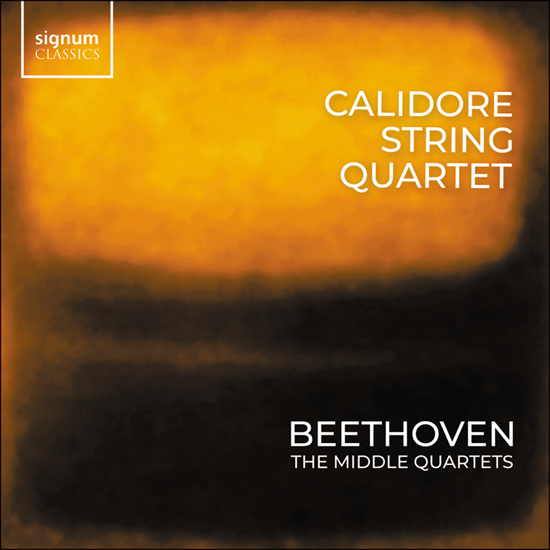BEETHOVEN 'The Middle Quartets' (Calidore Quartet)
View record and artist detailsRecord and Artist Details
Genre:
Chamber
Label: Signum Classics
Magazine Review Date: 10/2024
Media Format: CD or Download
Media Runtime: 159
Mastering:
DDD
Catalogue Number: SIGCD872

Tracks:
| Composition | Artist Credit |
|---|---|
| String Quartet No. 7, 'Rasumovsky' |
Ludwig van Beethoven, Composer
Calidore String Quartet |
| String Quartet No. 8, 'Rasumovsky' |
Ludwig van Beethoven, Composer
Calidore String Quartet |
| String Quartet No. 9, 'Rasumovsky' |
Ludwig van Beethoven, Composer
Calidore String Quartet |
| String Quartet No. 10, 'Harp' |
Ludwig van Beethoven, Composer
Calidore String Quartet |
| String Quartet No. 11, 'Serioso' |
Ludwig van Beethoven, Composer
Calidore String Quartet |
Author: Richard Wigmore
Any new recording of Beethoven’s quartets will provoke argument. Preconceptions inevitably play their part. What cannot be denied is the sophistication and sheer polish – in tuning, rhythm and ensemble – of the Calidore’s Beethoven. Following their justly praised (in Gramophone and elsewhere) set of late quartets (5/23), the New York-based group plunge into the ‘Rasumovsky’ Quartets, whose unprecedented scale and rhetorical force baffled early audiences. In the opening Allegro of Op 59 No 1 the Calidore set out their stall: a bracing tempo, close to Beethoven’s own quick metronome marking, and playing of quivering nervous intensity that sweeps over the bar lines. Without ever feeling rigid, the Calidore only relax for the first violin’s rhapsodic musings over sustained chords in the development (from 3'49"). Other quartets, including the Busch (Warner, 2/16), The Lindsays (ASV) and the Elias (Wigmore Hall Live), give the movement more space and take more to heart Beethoven’s requests for dolce. But on their own terms the Calidore are mightily compelling.
Without quite approaching the quicksilver, period-influenced Cuarteto Casals (Harmonia Mundi, 9/18, 5/19), the Calidore tend to favour fast tempos throughout the ‘Rasumovskys’. At the furthest extreme from the Elias and Lindsays, they prioritise explosive energy over whimsy and pathos in the fantastical second movement of No 1. Like so much in the ‘Rasumovskys’, the torrential finale of No 3 strains at the boundaries of the medium. This is a comic-opera overture on steroids. The Calidore, like the Busch but few others, come close to Beethoven’s fast metronome marking. You might protest that the viola starts the improbably long fugue subject too loudly. But in a performance of such fearless attack and rhythmic precision, who cares?
The fleet, syncopated Allegretto of No 2 and the feline elegance of No 3’s Minuet, with the semiquaver curlicues gliding seamlessly from instrument to instrument, are two other movements to relish here. In No 3’s exotic-mysterious Andante con moto the Calidore eschew the dreamlike inwardness of the Busch, Elias and Takács (Decca, 6/17) in favour of something brisker and edgier, with stinging accents and dynamic contrasts. Typically, they always think long. The Calidore use vocally inspired portamentos in the lamenting Adagio of Rasumovsky No 1 and the hymnic slow movement of No 2. To nitpick, I thought the first violin’s decorative countermelody too prominent in relation to the second violin’s chorale in No 2 (from bar 8). But the Calidore moved me with their tender, fine-drawn cantabile lines and glowing beauty of sonority, qualities singled out by Peter Quantrill in his review of the late quartets. The first violin’s benediction at the heart of No 1’s Adagio (from 7'09") is a transcendent moment, as Beethoven surely intended.
The Calidore are hardly less persuasive in the Harp and the troubled, fanatically compressed Quartetto serioso. The leader, Jeffrey Myers, vindicates a dangerously dreamy tempo in the Adagio ma non troppo of the Harp with his trademark purity of line and uncloying sweetness of tone. In the Scherzo the quartet play up the ambivalence between 3/4 and 6/8 metre which once fazed a delighted Schubert. A tiny but telling point in the first movement’s coda is the way the first violinist tempers his concerto fireworks at 8'44" to allow the song in the middle voices to shine through.
For my taste the cussed Scherzo of the Serioso – part march, part skewed waltz – is too deliberate; and in the Trio episodes the first violin’s restless quaver figuration tends to mask the chorale in the lower instruments. I also prefer the faster tempo adopted by the Busch and the Takács in the second movement, both of whom seem more attuned to the music’s strange, inward gaze. But the outer movements come off superbly. In the first the Calidore balance uncompromising ferocity (no hint of a ritardando at the end) with just enough flexibility to accommodate the shards of yearning song, while the valse triste finale is as urgent and distressed as Beethoven’s marking implies. The throwaway, laugh-it all-off coda gets feathery lightness and pinpoint precision: a miniature tour de force that sets the seal on Beethoven-playing of rare vividness and technical aplomb.
Discover the world's largest classical music catalogue with Presto Music.

Gramophone Digital Club
- Digital Edition
- Digital Archive
- Reviews Database
- Full website access
From £8.75 / month
Subscribe
Gramophone Full Club
- Print Edition
- Digital Edition
- Digital Archive
- Reviews Database
- Full website access
From £11.00 / month
Subscribe
If you are a library, university or other organisation that would be interested in an institutional subscription to Gramophone please click here for further information.




